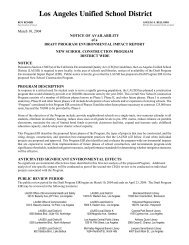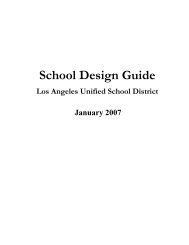Site-Specific Health and Safety Plan (HASP) - Laschools.org
Site-Specific Health and Safety Plan (HASP) - Laschools.org
Site-Specific Health and Safety Plan (HASP) - Laschools.org
Create successful ePaper yourself
Turn your PDF publications into a flip-book with our unique Google optimized e-Paper software.
LAUSD Proposed South Region High School #9 & Middle School #4<br />
12.0 SITE CONTROL MEASURES<br />
12-1<br />
December 2006<br />
<strong>Site</strong> <strong>Specific</strong> <strong>Health</strong> & <strong>Safety</strong> <strong>Plan</strong> (<strong>HASP</strong>)<br />
The following site control measures will be followed to minimize potential contamination of<br />
workers, protect the public from potential site hazards, <strong>and</strong> control access to the sites. <strong>Site</strong><br />
control involves the physical arrangement <strong>and</strong> control of the operation zones <strong>and</strong> the methods for<br />
removing COCs from workers <strong>and</strong> equipment. The first aspect, site <strong>org</strong>anization, is discussed in<br />
this section. The second aspect, decontamination, is considered in the next section. <strong>Site</strong> access<br />
will be coordinated with the LAUSD security located at the site.<br />
12.1 SITE ORGANIZATION-OPERATION ZONES<br />
The following <strong>org</strong>anization-operation zones will be established on the site or around a particular<br />
site feature, as needed.<br />
• Exclusion Zone (Contamination Zone),<br />
• Contamination Reduction Zone, <strong>and</strong><br />
• Support Zone.<br />
The Field Team Manager <strong>and</strong>/or SHSO will be responsible for establishing the size <strong>and</strong> distance<br />
between zones at the site or around the site feature, based on identified contamination.<br />
Considerable judgment is required to ensure that safe working distances for each zone are<br />
balanced against practical work considerations.<br />
Exhibit 12-1 shows the site control for a typical hazardous waste site.<br />
12.1.1 Exclusion Zone<br />
The exclusion zone includes the areas of drilling, excavation, hazardous waste removal, <strong>and</strong><br />
other remedial activities. Within the exclusion zone, prescribed levels of PPE must be worn by<br />
all personnel. The hotline, or exclusion zone boundary, is initially established based upon the<br />
presence of actual wastes or apparent spilled material, or through air monitoring, <strong>and</strong> is placed<br />
around all physical indicators of hazardous substances. The hotline generally consists of an<br />
easily identifiable physical boundary (e.g., bright orange or yellow flagging attached to stakes),<br />
<strong>and</strong> may be readjusted based upon subsequent observations <strong>and</strong> measurements. This boundary<br />
will be physically secured <strong>and</strong> posted or well-defined by physical <strong>and</strong> geographic boundaries,<br />
such as:<br />
• Red tape/flagging indicates Danger/Hot Zone/Stay Out/<strong>Specific</strong>ally trained <strong>and</strong><br />
authorized persons only.<br />
• Yellow tape/flagging indicates Caution/Warm Zone/ Proceed with caution.<br />
Under some circumstances, the exclusion zone may be subdivided into zones based upon<br />
environmental measurements or expected on site work conditions.<br />
12.1.2 Contamination Reduction Zone<br />
If decontamination is required, a contamination reduction zone will be established between the<br />
exclusion zone <strong>and</strong> the support zone. This zone provides an area to prevent or reduce the<br />
transfer of hazardous materials that may have been picked up by personnel or equipment leaving<br />
the exclusion area. All decontamination activities occur in this area. The <strong>org</strong>anization of the<br />
237







